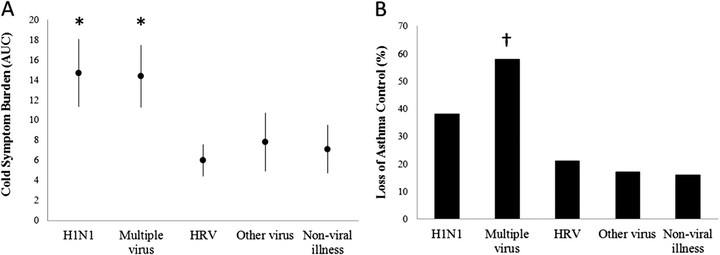
Abstract
RATIONALE: The 2009 H1N1 flu appeared to cause more severe cold symptoms during the 2009-2010 flu season. OBJECTIVES: We evaluated H1N1 infections during peak viral season in children with and without asthma to determine whether the H1N1 infectivity rate and illness severity were greater in subjects with asthma. METHODS: One hundred and eighty children, 4-12 years of age, provided eight consecutive weekly nasal mucus samples from September 5 through October 24, 2009, and scored cold and asthma symptoms daily. Viral diagnostics were performed for all nasal samples. MEASUREMENTS AND MAIN RESULTS: One hundred and sixty-one children (95 with asthma, 66 without asthma) completed at least 6 of the 8 nasal samples. The incidence of H1N1 infection was significantly higher in children with asthma (41%) than in children without asthma (24%; odds ratio, 4; 95% confidence interval, 1.8-9; P < 0.001), but rates of human rhinovirus infection (90% each) and other viral infections (47 vs. 41%) were similar. In children with asthma, there was a nonsignificant trend for increased loss of asthma control during H1N1 infections compared with human rhinovirus infections (38 vs. 21%; odds ratio, 2.6; 95% confidence interval, 0.9-7.2; P = 0.07). CONCLUSIONS: During peak 2009 H1N1 flu season, children with asthma were infected almost twice as often with H1N1 compared with other respiratory viruses. H1N1 infection also caused increased severity of cold symptoms compared with other viral infections. Given the increased susceptibility of children with asthma to infection, these findings reinforce the need for yearly influenza vaccination to prevent infection, and raise new questions about the mechanism for enhanced susceptibility to influenza infection in asthma.